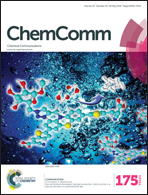Direct and reversible immobilization and microcontact printing of functional proteins on glass using a genetically appended silica-binding tag†
Abstract
Fusion of disulfide-constrained or linear versions of the Car9 dodecapeptide to model fluorescent proteins support their on-contact and oriented immobilization onto unmodified glass. Bound proteins can be released and the surface regenerated by incubation with L-lysine. This noncovalent chemistry enables rapid and reversibe microcontact printing of tagged proteins and speeds up the production of bicontinuous protein patterns.


 Please wait while we load your content...
Please wait while we load your content...